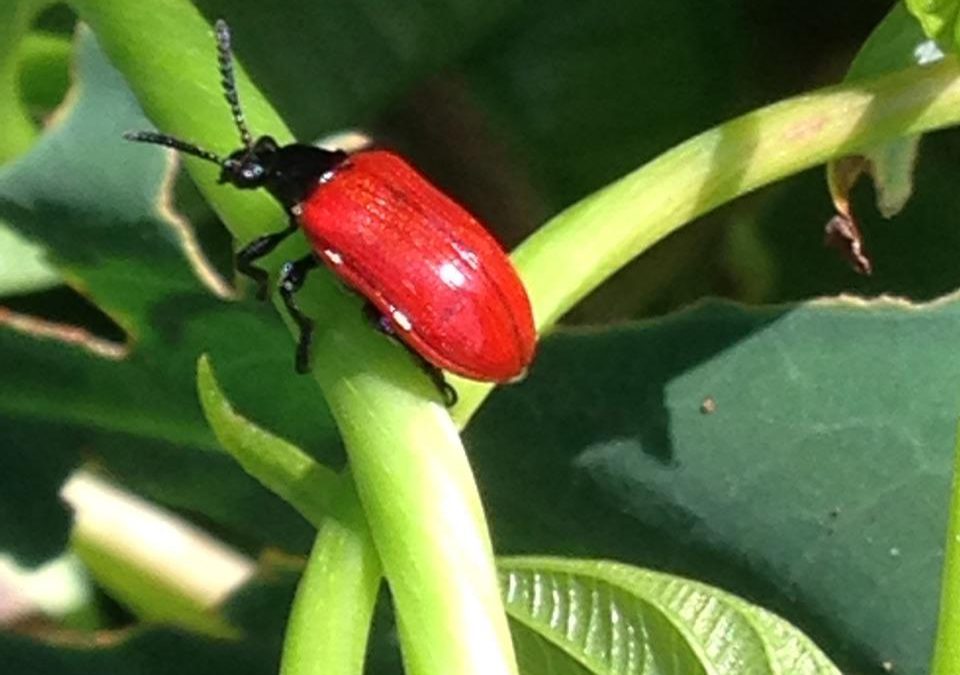
by Scott Jackson | May 25, 2018
By L. Scott Jackson and Julie B. McConnell, UF/IFAS Extension Bay County
Northwest Florida’s pristine natural world is being threaten by a group of non-native plants and animals known collectively as invasive species. Exotic invasive species originate from other continents and have adverse impacts on our native habitats and species. Many of these problem non-natives have nothing to keep them in check since there’s nothing that eats or preys on them in their “new world”. One of the most problematic and widespread invasive plants we have in our local area is air potato vine.
Air potato vine originated in Asia and Africa. It was brought to Florida in the early 1900s. People moved this plant with them using it for food and traditional medicine. However, raw forms of air potato are toxic and consumption is not recommended. This quick growing vine reproduces from tubers or “potatoes”. The potato drops from the vine and grows into the soil to start new vines. Air potato is especially a problem in disturbed areas like utility easements, which can provide easy entry into forests. Significant tree damage can occur in areas with heavy air potato infestation because vines can entirely cover large trees. Some sources report vine growth rates up to eight inches per day!
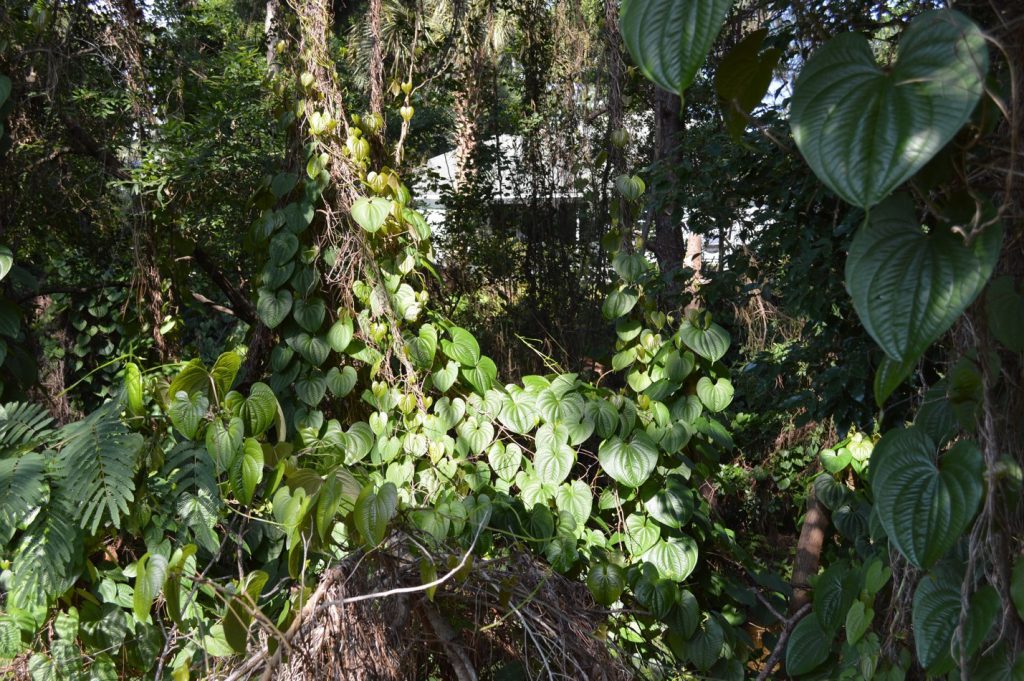
Air Potato vines covering native shrubs and trees in Bay County, Florida. (Photo by L. Scott Jackson)
Mechanical removal of vines and potatoes from the soil is one control method. Additionally, herbicides are often used to remediate areas dominated by air potato vine but this runs the risk of affecting non-target plants underneath the vine. A new tool for control was introduced to Florida in 2011, the air potato leaf beetle. Air potato beetle releases have been monitored and evaluated by United States Department of Agriculture (USDA) researchers and scientists for several years.

Air Potato Beetle crawling on leaf stem. Beetles eat leaves curtailing the growth and impact of air potato. (Photo by Julie B. McConnell)
Air potato beetles target only air potato leaves making them a perfect candidate for biological control. Biological controls aid in the management of target invasive species. Complete eradication is not expected, however suppression and reduced spread of air potato vine is realistic.
UF/IFAS Extension Bay County will host the Air Potato Challenge on June 6, 2018. Citizen scientist will receive air potato beetles and training regarding introduction of beetles into their private property infested with air potato vine. Pre-registration is recommended to receive the air potato beetles. Please visit http://bit.ly/bayairpotato
In conjunction with the Air Potato Challenge, UF/IFAS Extension Bay County will be hosting an invasive species awareness workshop. Dr. Steve Johnson, UF/IFAS Associate Professor of Wildlife Ecology, will be presenting “Exotic Invaders: Reptiles and Amphibians of Concern in Northwest Florida”. Additionally, experts from UF/IFAS Extension, Florida Fish and Wildlife, and the Science and Discovery center will have live exhibits featuring invasive reptiles, lionfish, and plants. For more information visit http://bay.ifas.ufl.edu or call the UF/IFAS Extension Bay County Office at 850-784-6105.
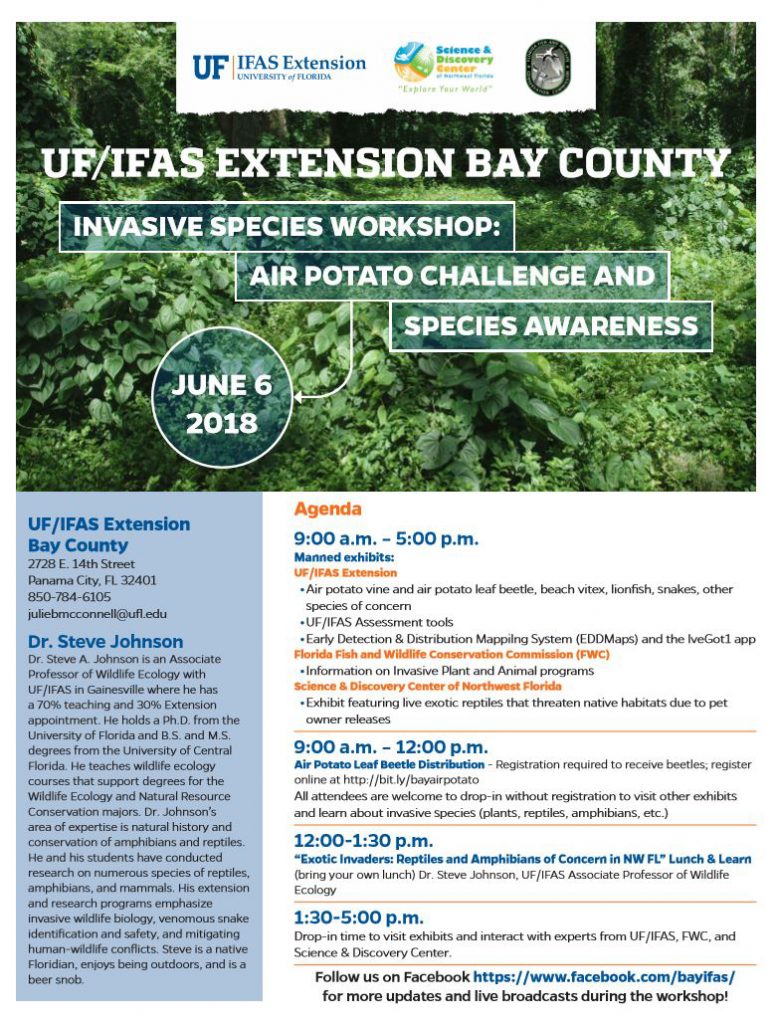
Flyer for Air Potato Challenge and Invasive Species Workshop June 6 2018
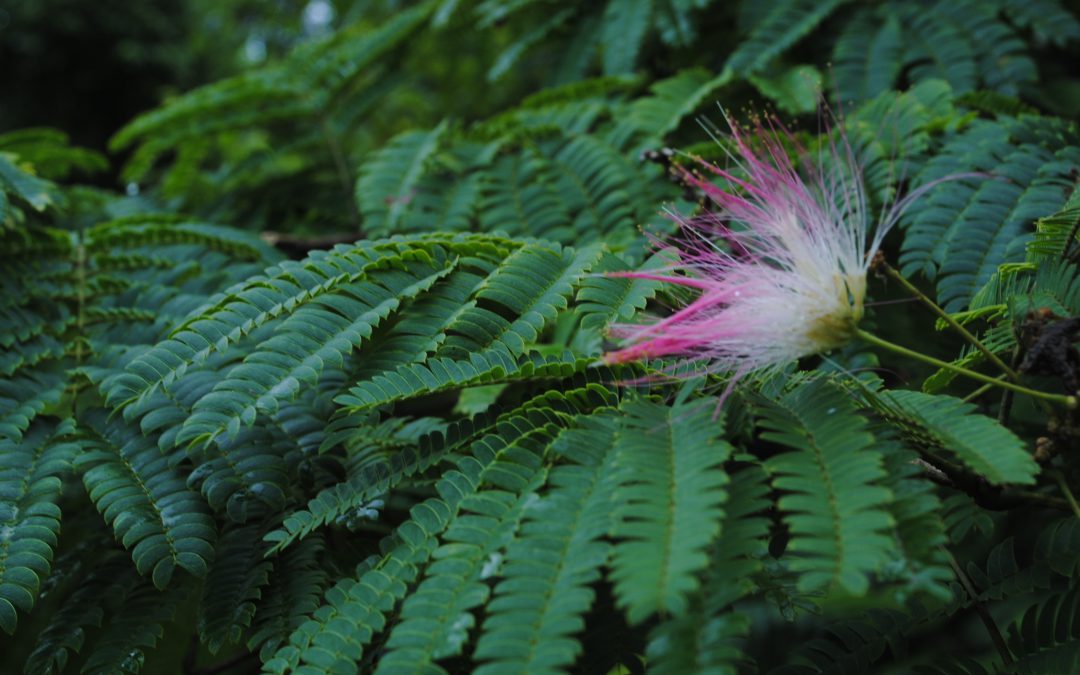
by Les Harrison | Mar 18, 2018
It is easy to notice the display of bright pink puffs erupting on low-growing trees along roadsides. This attractive plant is the Mimosa tree, Albizia julibrissin.
These once popular small trees are commonly found in the yards of older homes in Florida where the display of prolific blooms starts up as the weather warms.
This species is also classified as invasive native to southwest and eastern China, not Florida. Many Florida residents may not realize this tantalizing beauty is actually an aggressive invader in disguise.

The beautiful mimosa is found throughout the Florida panhandle.
Photo: Les Harrison
It has spread from southern New York west to Missouri south to Texas. It is even considered an invasive species in Japan.
Worse yet, mimosas are guilty of hosting a fungal disease, Fusarian, which will negatively affect many ornamental and garden plants. Some palms as well as a variety of vegetables will succumb to this pathogen.
In natural areas the invader will disrupt not only other plants, but also the birds, mammals, amphibians, and insects which depend on the displaced plants for food, shelter and habitat. Other negative traits include the disruption of water flow and aiding the incidence of wildfires.
In natural areas, mimosas tend to spread into dense clumps blocking the light to native plants which prevents them from growing. They are prominent along the edges of woods and wetland areas where seeds scatter easily and take advantage of sheltered, sunlit spots.
Mimosa tree seeds can stay viable for many years in the soil. These seeds will float without damage to their germination potential until they wash ashore to colonize a new site.
Additionally, Mimosa tree seeds are attractive to wildlife. One tree in a yard can infest many acres with the aid of birds and small mammals.
Cut or wind snapped trees quickly regrow from the stump, making this one invader that is difficult to eradicate.
Fortunately, there are a variety of small trees which can replace the Mimosa tree in home landscapes. Many are attractive, but without the unrelenting need to populate the entire subdivision.
This is a beauty-and-the-beast combo tree with too many problems to compensate for its looks.
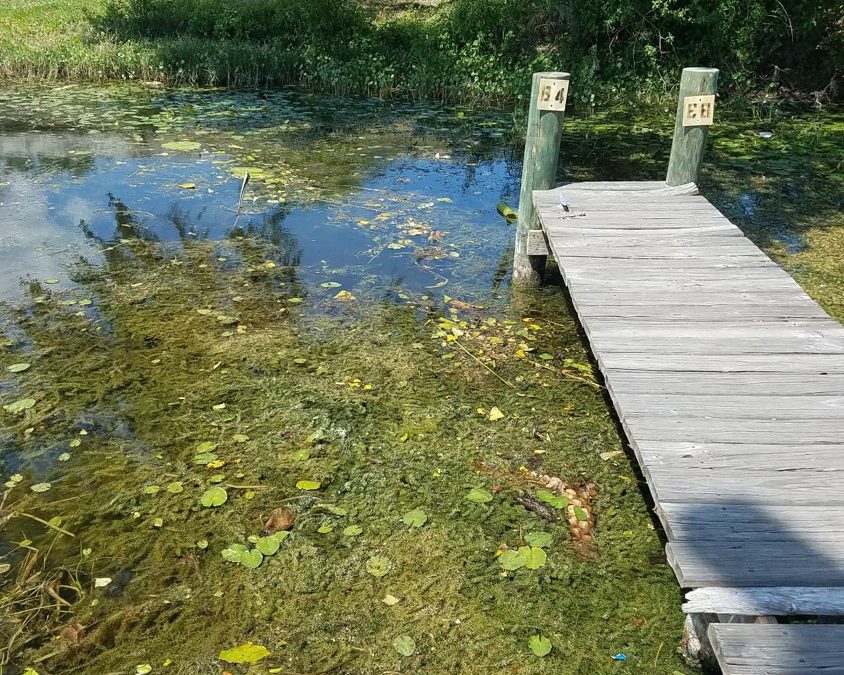
by Judy Biss | Mar 18, 2018

Adult grass carp, Ctenopharyngodon idella Val. Credit: Jeffrey E. Hill, University of Florida
Spring is only days away. Everywhere you look, plants of all kinds are awakening to recent rains, longer days, and fertile soils; and this includes aquatic plants as well! Florida has hundreds of aquatic plant species, and they are an often-overlooked feature of Florida’s landscape. Overlooked that is, until the growth of non-native (or even some native) species interferes with use of our waters. Some aquatic plant species can become problematic in Florida waters as their growth interferes with fishing, flood control, navigation, recreation, livestock watering, or irrigation. For these reasons, being knowledgeable about properly managing aquatic plants is important to the many uses of Florida’s waters, whether it be a state managed public waterbody, or your own backyard farm pond.
Any pest, whether plant, animal, or insect, is best managed using “IPM” or Integrated Pest Management. IPM involves using a variety of available management “tools” to control pests in an economically and environmentally sound manner. As in any IPM effort, the first thing to do is identify what is causing the problem. Next, define what your management goals are. Then, research what tools are available for you to manage the problem. And finally, devise and implement your management plan.
In this article, we will look at one of the IPM “tools” used to manage aquatic plants – the grass carp (Ctenopharyngodon idella Val.). The use of grass carp to manage problematic levels of aquatic plants falls under the general management term of “biological control.” Biological control essentially uses one living organism to control another living organism. Grass carp have become one of the most widely recognized examples of biological control.
The Grass Carp
As the name implies, the grass carp is an herbivorous fish that eats plants. It is native to eastern Russia and China living in large muddy rivers and associated lakes, and is actually one of the largest members of the minnow family. According to the Florida Fish and Wildlife Conservation Commission the largest triploid grass carp taken in Florida was 15 years old, 56″ long and weighed 75 pounds! The grass carp has been introduced into more than 50 countries and is used as a food item in many places around the world. They are used in nearly all states of the USA to manage aquatic plants.
Introduction into the United States:
“The grass carp was considered for introduction into the U.S. primarily because of its plant-eating diet, which was thought to have great potential for the control of aquatic weeds. In 1963 the U.S. Bureau of Sport Fisheries and Wildlife Fish Farming Experiment Station, Stuttgart, Arkansas, in cooperation with Auburn University, imported grass carp for experimental purposes; in 1970, this fish was introduced into Florida primarily for researchers to study its ability to control hydrilla.” (Grass Carp: A Fish for Biological Management of Hydrilla and Other Aquatic Weeds in Florida). “Early release of diploid fish led to reproductive populations in several US drainage systems, including the Mississippi River and major tributaries” (Grass Carp, the White Amur: Ctenopharyngodon idella Cuvier and Valenciennes (Actinopterygii: Cyprinidae: Squaliobarbinae))
Development of the Sterile Triploid
According to the UF/IFAS publication, Grass Carp, the White Amur: Ctenopharyngodon idella Cuvier and Valenciennes (Actinopterygii: Cyprinidae: Squaliobarbinae), “Use of the fish was limited from 1970 until 1984 due to tight regulations surrounding concerns of escape and reproduction, and the potential impacts that colonization of the fish could have on native flora and fauna. These concerns led to research that developed a non-reproductive fish, which was equally effective in controlling hydrilla.” This non-reproductive fish is known as the triploid grass carp. Through a process of subjecting fertilized grass carp eggs to heat, cold, or pressure, the resulting fish have an extra set of chromosomes rendering the fish sterile. Triploid carp have the same herbivorous characteristics as the normal diploid carp, but they are unable to spawn and reproduce. Their inability to reproduce is what makes them a viable tool to manage aquatic plants, and that is because their numbers and feeding pressure can be controlled, they cannot overpopulate a waterbody, nor if they escape, will they overpopulate un-managed areas.
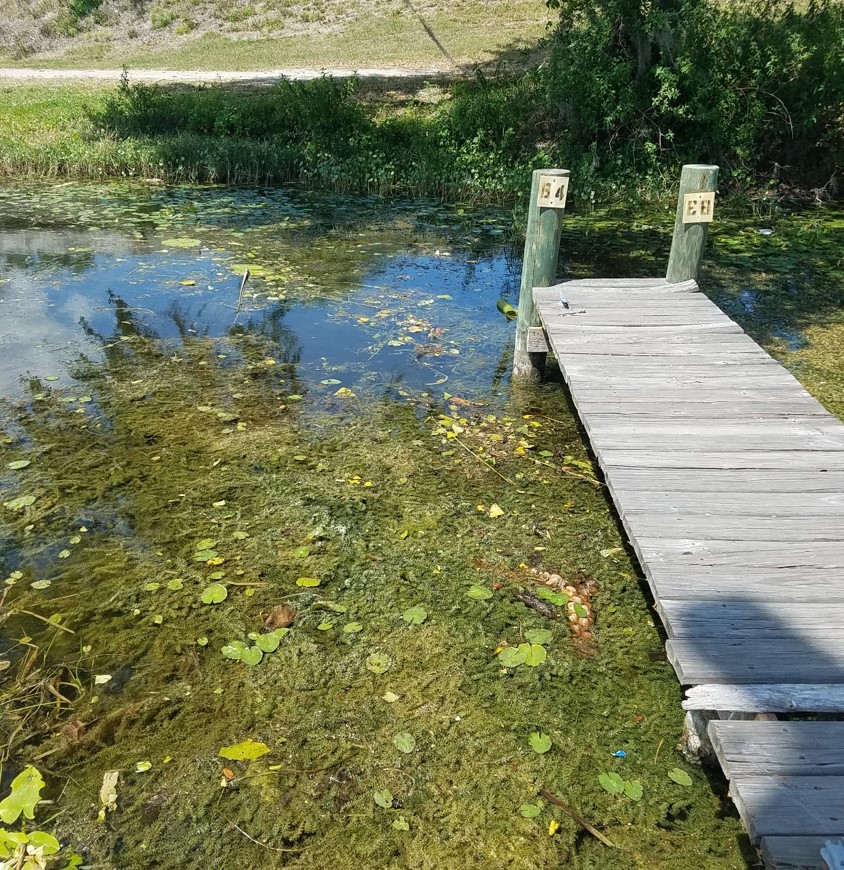
The growth of invasive non-native (or even some native) aquatic plant species can interfere with the many uses of Florida’s waters. This is invasive hydrilla mixed with water lilies in a Florida lake. Photo by Judy Biss
What kinds of aquatic plants do they eat?
The grass carp grazes on many types of aquatic plants, but it does have its preferences. Its most preferred aquatics plants are hydrilla, chara (musk grass), pondweed, southern naiad, and Brazilian elodea. Its least favorite aquatic plants are species such as water lily, sedges, cattails, and filamentous algae. It will, however, graze on many types of plants even shoreline or overhanging vegetation in the absence of its preferred foods. Another reason the grass carp is an effective plant management tool is because it eats many times its body weight in plant material. As stated in Grass Carp, the White Amur: Ctenopharyngodon idella Cuvier and Valenciennes (Actinopterygii: Cyprinidae: Squaliobarbinae), “every 1 lb. increase in fish weight requires 5–6 lbs. of dry hydrilla (Sutton et al. 2012), which—considering hydrilla is 95% water—is a great deal of live plant material.”
Use of Grass Carp as a Biological Control:
Integrating the use of grass carp in aquatic plant management plans is usually cost effective. In many cases involving the use of grass carp, overabundant aquatic weed infestations are first treated with an aquatic herbicide to reduce biomass. The carp are then stocked to control regrowth and to extend the time between herbicide treatments. This can be up to 5 or more years, depending on the situation. One factor in long term control is the survival of the stocked grass carp. They are not without predators as largemouth bass, otters, birds, etc. readily prey on small grass carp. Stocked fish should be at least 12 inches long to help avoid predation and provide plant control. Other considerations to factor into your management plans are the long term, yet non-specific, control that grass carp can provide. If not stocked in the correct manner, they may end up eating aquatic plants that you wish to maintain. Also, if they eat all the aquatic plants, your once clear water may become dominated by algae instead.
How can I get grass carp for my lake or pond?
The Florida Fish and Wildlife Conservation Commission (FWC) administers the Grass Carp program for Florida. A permit is required before you can purchase carp, and only the sterile triploid carp are permitted for use in Florida. The FWC can answer many questions about the use of grass carp and if this aquatic plant management “tool” is the right one for you to use in your particular situation. In north Florida, the regional FWC office is located at 3911 Highway 2321 Panama City, FL 32409, Phone: 850-767-3638.
What do I need to know about triploid grass carp?
Cost: Triploid grass carp cost between $5 and $15 each and are usually stocked at three to ten fish per acre, resulting in costs as low as $15 per acre. In comparison, herbicides cost between $100 and $500 per acre and mechanical control may cost more than twice that.
Time: Grass carp usually take six months to a year to be effective in reducing problem vegetation, although they provide much longer term control than other methods, often up to five years before restocking is necessary. When used in conjunction with an initial herbicide treatment, control of problem vegetation can be achieved quickly, and fewer carp are required to maintain the desired level of vegetation.
Overstocking: Once stocked in a lake or pond, carp are very difficult to remove. If overstocking occurs, it may be ten years or more before the vegetation community recovers. Even after carp are removed, other herbivores such as turtles may prevent the regrowth of vegetation.
Water Clarity: Aquatic plants remove nutrients in the water. When plants are removed, nutrients may then be utilized by phytoplankton, turning the water green. Clarity may be improved by reducing or eliminating sources of nutrients into the lake such as road runoff and lawn fertilizer.
Inflows/Outflows: It is in the best interest of people stocking carp to keep them in the desired lake or pond. It is also a required condition of the permit. Any inflows or outflows through which carp could escape into other waters require barriers to prevent fish from escaping into waters not permitted.
For more information on this topic, please see the following resources used for this article:
Aquatic and Wetland Plants in Florida
Plant Management in Florida Waters
Grass Carp, the White Amur: Ctenopharyngodon idella Cuvier and Valenciennes (Actinopterygii: Cyprinidae: Squaliobarbinae),
Grass Carp: A Fish for Biological Management of Hydrilla and Other Aquatic Weeds in Florida).
Chinese Grass Carp
FWC Triploid Grass Carp Permit
UF/IFAS Center for Aquatic and Invasive Plants – Aquatic Plant Control Methods
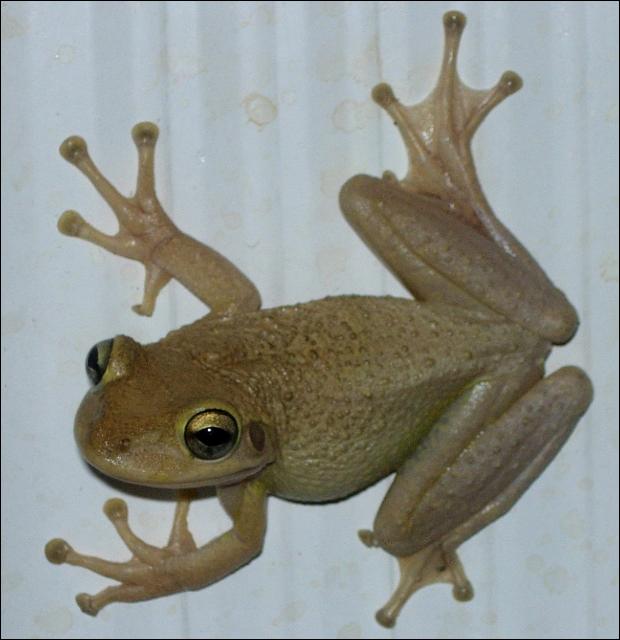
by Rick O'Connor | Mar 10, 2018
As we come to the end of National Invasive Species Awareness Week (NISAW), I need to educate everyone on a potential invasive threat, a classic Early Detection Rapid Response (EDRR) species – the Cuban Treefrog.
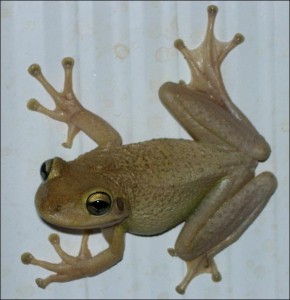
is this a Cuban Tree Frog? Do I have to rely on DNA barconding to know for sure – before I decide to euthanize it? Could I be making a mistake?
Image by Dr. Steve A Johnson 2005.
This treefrog was first introduced into to south Florida in the 1920’s. Like lionfish, it quickly became established and began its slow dispersal northward. It is a large predatory frog (reaching about 5”) which began to consume native treefrogs, reducing their populations wherever they were found. In addition to consuming native frogs, Cuban Treefrogs eat snails, millipedes, spiders, and many other small creatures. They can produce a call that is somewhat annoying to many residents where it is found. It is currently listed as established as far north as Gainesville FL.
A few years ago, I received a call from a resident near Big Lagoon in southwest Escambia County. They had just purchased plants from a local chain store to plant in their yard the following day. They had left the plants on the front porch that night and, at some point, noticed this large treefrog on their front door. They wanted to know if this was a non-native frog. It was – it was the Cuban Treefrog. The animal was collected and sent to the University of Florida.
This is a common method of transporting this frog north. They attach to ornamental plants grown in nurseries in south Florida. The plants are loaded on trucks and shipped to the panhandle and locations north and west. There are probably numerous species hitching rides this way, including the Cuban Anole (an invasive lizard). Lucky for us, in many cases these tropical problem species cannot tolerate our cold winters – this could also be said for some of the invasive plants. However, in recent years, the winters have been milder and some of these species are surviving. Most of us know and understand the impact lionfish have had on local small reef fish; no one is interested in another “lionfish problem” in the panhandle.
About a year ago, a second Cuban Treefrog was reported in Crestview.
Early this year I attended an amphibian/reptile conference in north Georgia. There was a presentation given by a scientist from the U.S. Geological Survey in Lafayette LA. He had a call from the Audubon Zoo in New Orleans about a strange frog they had been finding. They had recently purchased palm trees from south Florida for the elephant exhibit. The caretakers of the exhibit began to see strange frogs and reported it. When USGS arrived, they meandered through the park searching. They stopped by the public bathroom to look (a place I have found them in south Florida myself). They happen to pass an electric panel outside the restroom and decided to take a peak – 13 Cuban Treefrogs were within.
They began an exhaustive search and found CTFs everywhere. Most had moved into a public park between the zoo and the river called Riverview. I cannot remember how many they had found but it was in the hundreds, the animals were beginning to establish themselves in this area of New Orleans. USGS is currently working on the problem.
Just a few weeks ago, a Cuban Treefrog was found on Davenport Bayou off Bayou Grande.
There are many reports of single, individual CTFs across the northern Gulf coast, but none were established populations. However, as reports increase we should be looking for these animals and try to keep them under control before they do. No more “lionfish problems”.
How do we do this?
The following link provides information about the frog, how to identify it, how to set traps to determine if the animal is in your neighborhood, and what to do if you do find one. I would include reporting the finding on www.EDDMapS.org. I also recommend as you purchase plants for this spring’s landscaping projects, check the plants carefully for any hitchhikers. This “early detection” method is the most effective way to battle the movement of invasive species.
If you have questions about Cuban Treefrogs, let me know.
Johnson, S.A. 2017. The Cuban Treefrog (Osteopilus septentrionalis) in Florida. University of Florida Extension Electronic Data Information Source (EDIS) document WEC218.
http://edis.ifas.ufl.edu/uw259.
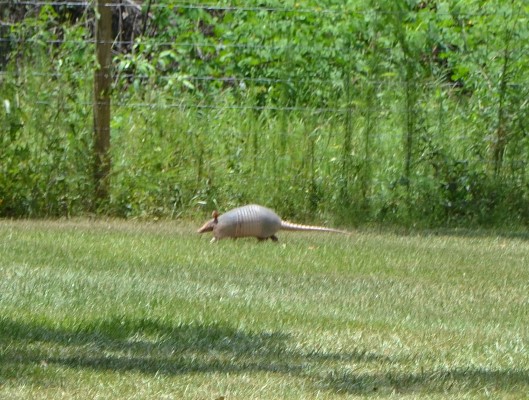
by Les Harrison | Mar 9, 2018
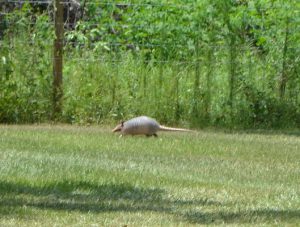
The common nine banded armadillo scurrying across the lawn.
Photo: Les Harrison
The first light of morning can reveal random pockmarks in what had been the perfect lawn the previous evening. The culprit is not likely the neighborhood teenager with a reputation for inappropriate practical jokes.
The offender usually is the nine-banded armadillo, sometimes referred to as a Florida-speed-bump or Possum-on-the-half-shell. In addition to manicured landscapes, they also encroach in natural areas and destroy sensitive habitats.
Armadillos eat adult insects and larvae, but also quail and turtle eggs. They incessantly dig holes in their search for food, many times uprooting plants in their food search. Their foraging holes are approximately one to three inches deep and three to five inches wide.
Using insecticides in landscapes to decrease the armadillo food supply is not guaranteed, but may help reduce the digging. In cases where there is a large, and always ravenous, armadillo population this reduction of food may increase digging activity as they search more diligently for a smaller food supply.
Another consideration is all chemical treatments have to be reapplied on a permanent basis for long term control. Always read and follow label instructions for safe use of insecticides.
Armadillos rest in a deep burrow during the day and are usually active after dark. Burrows openings are approximately seven to eight inches in diameter, about the size of a one-gallon plastic jug, and up to 15 feet in length.
This exotic invasive may burrow under driveways, foundations and patios potentially causing structural damage. Additionally, their burrows in pastures pose a potential leg-injury hazard to large wildlife and livestock.
Several live-trapping techniques can be used to capture armadillos as they exit of their burrows. Because armadillos are nocturnal, trapping techniques designed to capture them as they emerge from their burrows should be applied late in the afternoon and checked several hours after darkness.
Fencing is another option to discourage the presence of armadillos. Relocating captured animals is illegal and not recommended because it only transfers the problem elsewhere and can spread this problem species.
Fossil records indicate the armadillo’s ancestors were as large as modern-day rhinos. One can only imagine what front yards would look like if they still existed.

by Carrie Stevenson | Mar 2, 2018
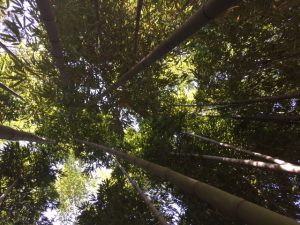
Bamboo shoots. Photo credit: Carrie Stevenson
Standing in the midst of a stand of bamboo, it’s easy to feel dwarfed. Smooth and sturdy, the hollow, sectioned woody shoots of this fascinating plant can tower as tall as 70 feet. Unfortunately, bamboo is a real threat to natural ecosystems, moving quickly through wooded areas, wetlands, and neighborhoods, taking out native species as it goes.
We do have one native species referred to as bamboo or cane (Arundinaria gigantea), which is found in reasonable numbers in southeastern wetlands and the banks of rivers. There are over a thousand species of true bamboo, but chief among the invasive varieties that give us trouble is Golden Bamboo (Phyllostachys aurea). Grown in its native Southeast Asia as a food source, building material, or for fishing rods, bamboo is also well known as the primary diet (99%) of the giant panda. In the United States, the plant was brought in as an ornamental—a fast growing vegetative screen that can also be used as flooring material or food. Clumping bamboos can be managed in a landscape, but the invasive, spreading bamboo will grow aggressively via roots and an extensive network of underground rhizomes that might extend more than 100 feet from their origin.
As a perennial grass, bamboo grows straight up, quickly, and can withstand occasional cutting and mowing without impacts to its overall health. However, a repeated program of intensive mowing, as often as you’d mow a lawn and over several years, will be needed to keep the plant under control. Small patches can be dug up, and there has been some success with containing the rhizomes by installing an underground “wall” of wood, plastic, or metal 18” into the soil around a section of bamboo.
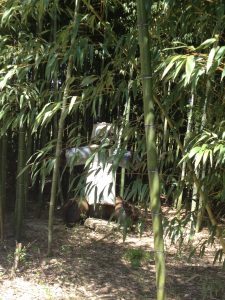
Whimsy art Panda in a bamboo forest at the Glendale Nature Preserve. Photo credit: Carrie Stevenson
While there are currently no chemical methods of control specifically labeled for bamboo at this time, the herbicides imazapyr (trade name Arsenal and others) or glyphosate (Round-up, Rodeo) applied at high rates can control it. According to research on the topic, “bamboo should be mowed or chopped and allowed to regrow to a height of approximately 3 feet, or until the leaves expand. Glyphosate at a 5% solution or imazapyr as a 1% solution can then be applied directly to the leaves.” These treatments will often need to be repeated as many as four times before succeeding in complete control of bamboo.
Land managers should know that while imazapyr is typically a more effective herbicide for bamboo, it can kill surrounding beneficial trees and shrubs due to its persistence in the contiguous roots and soil. In contrast, glyphosate solutions will only kill the species to which it has been applied and is the best choice for most areas managed by homeowners.
Bamboo Control: http://edis.ifas.ufl.edu/pdffiles/AG/AG26600.pdf
















